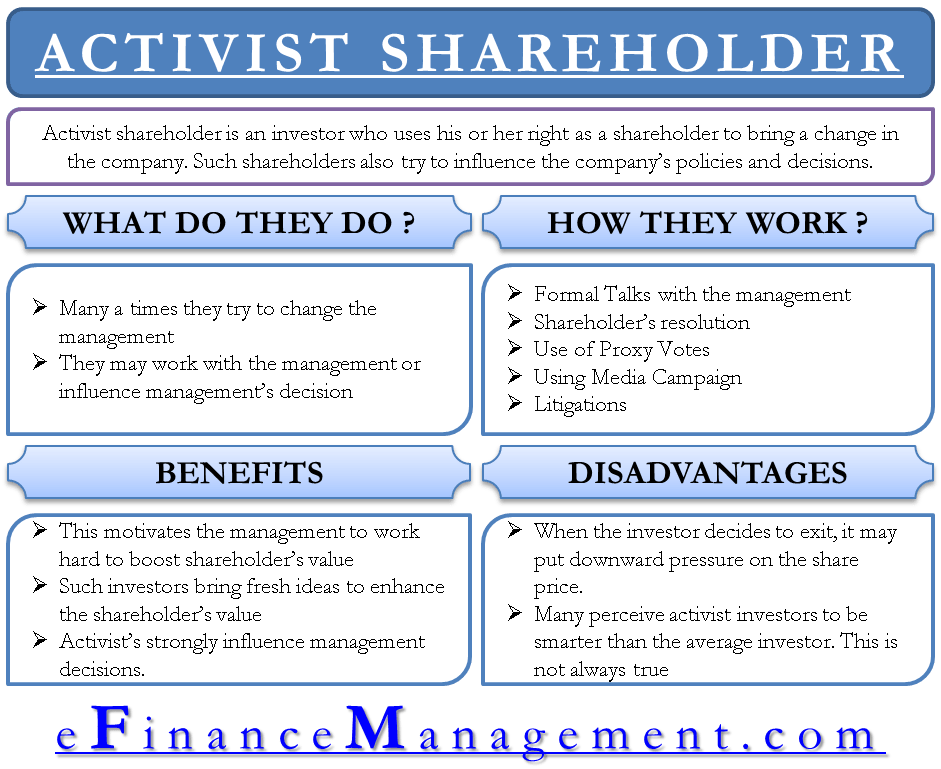An activist shareholder is an investor who uses their right as a shareholder to bring a change in the company. Such shareholders also try to influence the company’s policies and decisions.
A public company is expected to act in the best interest of its shareholders. However, what constitutes the best interest is a matter of debate. So, when activist shareholders are there, management acts more responsibly to ensure that their decision and policies are pro shareholders.
Reviewing a company’s SEC Form 13-D filings easily tells if a company is prone to activist investors. The SEC filing reveals if a shareholder owns more than 5% of the company’s shares.
What Do They Do?
Many times, activist shareholders try to change the management team for better results. Carl Icahn is one such activist shareholder. Also known as the corporate ‘raiser’ in the 1980s, he usually buys a significant stake in a company. He then pressures the management to make undesirable decisions that eventually enhance the shareholder value.
So, when an investor like Carl Icahn invests in any company, its share price usually goes up. An increase in share price is not because the market believes the company is trading below its market value but because investors believe Icahn will act in the best interest of the shareholders.
Icahn’s hostile takeover of the TWA airline in 1985 is one of his biggest achievements. He not only took over the company but also steered it from the brink of bankruptcy.
Activist investors may work with the management or influence management’s decisions on a variety of matters. Such as altering the company’s product lines, company’s environmental policies, compensation plans, financial policies, political matters, and more.
It is not essential for an activist shareholder to own a big equity stake in the company. However, having a big stake does help in exerting a stronger influence on management. But, acquiring a big stake is costly and often faces resistance from other shareholders.
Also Read: Shareholders Vs Stakeholders

How do Activist Shareholders Work?
Different classes of equity shares come with distinct privileges, such as voting rights, the right to dividends, and more. Activist shareholders have several ways to influence the decision of management. These ways are:
Formal Talk with Management
Often activist shareholders are able to get their viewpoint across or achieve their goal by having a simple talk with the management. If management disagrees with the activist shareholders’ views, then the latter can resort to other ways.
Shareholder Resolution
Under this, shareholders submit a proposal for a vote at the company’s annual general meeting. Though companies usually oppose such proposals, such a method helps gain public attention.
Use of Proxy Votes
Activist shareholder often uses proxy votes to get the proposal in their favor. A proxy vote is of a shareholder who is unable to attend the shareholder meeting and transfers his voting right to a representative.
Using Media Campaigns
It is an effective way to get the attention of the public to a problem or an issue with the company or its management. One may also use such campaigns in addition to the above measures to exert pressure on the company’s management.
Litigation
Activist shareholders can also take the management to court to achieve their goal. Such a route is not preferable as it may impact the company’s share price, thus, defeating activist shareholders’ primary objective of boosting shareholder value.
Benefits
- Activist shareholders are big enough to hold management responsible and demand results. This, in turn, leads to management working hard to boost shareholders value.
- Often it has been seen that such investors bring fresh ideas with them to enhance shareholder value. It is not mandatory for management to listen to these ideas, but it is always good to have more options.
- Activist investors usually buy large quantities of stock in a short time. And, it has been seen that others also try to copy the moves by activist investors to benefit. Such massive buying in the stock pushes the demand and the price of the stock up.
- Some activist investors are powerful enough to bend management to make certain changes in the company’s policies.
Disadvantages
- When activist investors enter a stock, its share price usually goes up. However, when the investor decides to exit, it may put downward pressure on the share price.
- Activist investors convince other shareholders and the media that they are working in the best interest of the shareholders. However, it may be that they are only concerned about themselves.
- Many perceive activist investors to be smarter than the average investor. However, this is not always true, and they may also make an error in judgment.
Rising Shareholder Activism
As per a Q1 2015 CFO Signals survey, about three-quarters of public company CFOs, who were surveyed, have faced shareholder activism in some form. Separately, as per the analysis by Sustainable Investments Institute, 464 resolutions were proposed by shareholders last year, compared to 407 in 2010. However the number was 494 in 2017, but several proposals were withdrawn in 2018 owing to quiet deals with the management.
On the other hand, companies and their associations are pushing for legislation to make shareholder activism harder. Companies are trying to raise the minimum requirement for re-submitting a resolution, which failed previously. Further, they are also requesting the SEC (Securities and Exchange Commission) to come up with more rules for regulating proxy advisers.
Continue reading – Marginal Investor. A marginal investor is one who holds large number of shares and actively trades them.

